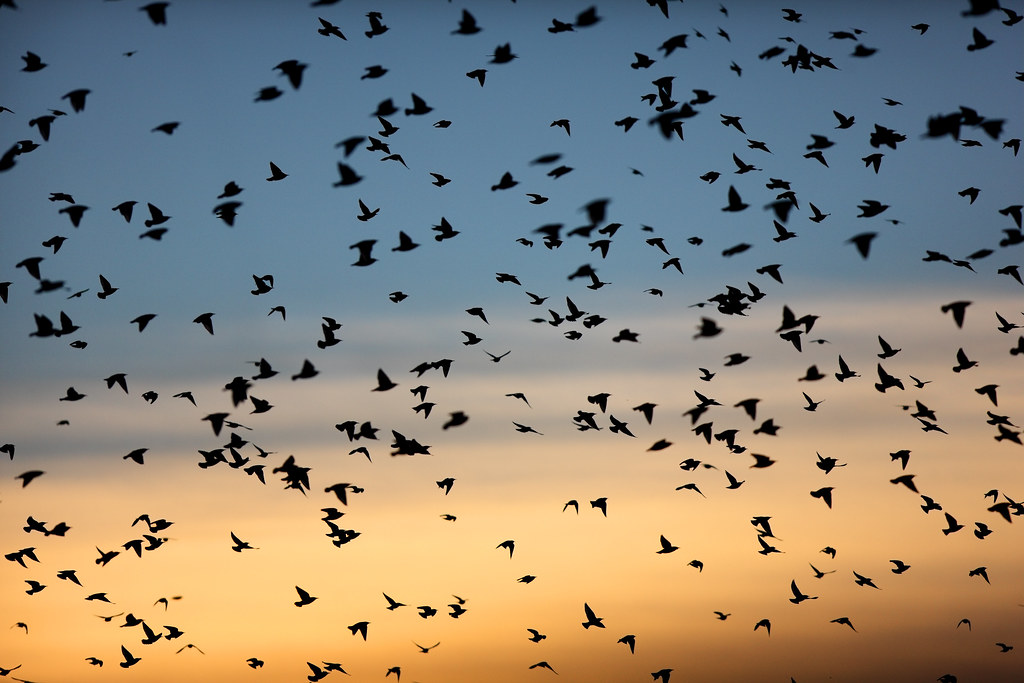The Beautiful Starling Murmurations at Brighton Pier
Every winter, starlings escaping the harsh Scandinavian winter migrate to the British Isles and other mild European countries. Starlings feed in gardens and farmland in the daytime and gather in huge groups called murmurations over Brighton Pier in late afternoon. Murmurations are thought to serve a number of purposes. Firstly, they are a defensive strategy against birds of prey; each starling monitors and shadows seven of its neighbours and this leads to murmurations adopting a typical fluid movement. Should a predatory bird attempt to intercept a murmuration, each starling in its path will automatically move aside, allowing the adversary to pass straight through. Flying in murmurations generates body heat and the collective warmth of bodies acts as a giant radiator when the starlings roost. Competition for the most sheltered places to roost is fierce and dominant males get first preference. Females and juveniles have to sleep in more exposed spots.
Although migrant starlings begin arriving in late October, the best time to watch murmurations is from January to March, half an hour before sunset. Viewing quality is influenced by weather conditions. Cold, clear sunny weather is the best time, as starlings will spend longer on the wing, probably to generate body warmth for the long night ahead. Clear, sunny and mild weather causes starlings to arrive at the pier very close to sunset and roost shortly afterwards. The sudden arrival of heavy downpours, accompanied by high winds and thunder, will prompt starlings to leave their feeding grounds up to one hour before sunset, but adverse weather does not seem to deter starlings from gathering in murmurations. I have seen murmurations lasting ten minutes in hail, gale force winds and thunder and lightning.
Photographing murmurations on Brighton Pier is a good opportunity to meet people. I've met several Flickr contacts this way and it's always nice to chat with interested members of the public. Photography is about taking pleasure in sharing - sharing my work online, showing my work to people on my tablet and of course sharing the actual experience in the company of others. If you're interested in meeting me, just send me an email or come and say hello on the day.
Wildlife photography is a tricky field. So many events have to occur at the same time for an image to work. Owning high end lenses and camera bodies is just one element in a complex array of variables. Wet, windy and cloudy weather this winter limited opportunities for photography. Often, when the sun did shine, mid-level cloud over the horizon blotted it out. Luckily, my desire to bring you a quality selection of photos, coupled with patience and perseverance, meant that I was down Brighton Pier at every available opportunity. I have now reached the half-way stage of my starling photography. The next instalment of photos will be posted in late March. In the meantime, I hope you enjoy looking at what I've taken so far.
Although migrant starlings begin arriving in late October, the best time to watch murmurations is from January to March, half an hour before sunset. Viewing quality is influenced by weather conditions. Cold, clear sunny weather is the best time, as starlings will spend longer on the wing, probably to generate body warmth for the long night ahead. Clear, sunny and mild weather causes starlings to arrive at the pier very close to sunset and roost shortly afterwards. The sudden arrival of heavy downpours, accompanied by high winds and thunder, will prompt starlings to leave their feeding grounds up to one hour before sunset, but adverse weather does not seem to deter starlings from gathering in murmurations. I have seen murmurations lasting ten minutes in hail, gale force winds and thunder and lightning.
Photographing murmurations on Brighton Pier is a good opportunity to meet people. I've met several Flickr contacts this way and it's always nice to chat with interested members of the public. Photography is about taking pleasure in sharing - sharing my work online, showing my work to people on my tablet and of course sharing the actual experience in the company of others. If you're interested in meeting me, just send me an email or come and say hello on the day.
Wildlife photography is a tricky field. So many events have to occur at the same time for an image to work. Owning high end lenses and camera bodies is just one element in a complex array of variables. Wet, windy and cloudy weather this winter limited opportunities for photography. Often, when the sun did shine, mid-level cloud over the horizon blotted it out. Luckily, my desire to bring you a quality selection of photos, coupled with patience and perseverance, meant that I was down Brighton Pier at every available opportunity. I have now reached the half-way stage of my starling photography. The next instalment of photos will be posted in late March. In the meantime, I hope you enjoy looking at what I've taken so far.


Comments
- I was looking at coming to Brighton to photograph/see the Starlings for myself. Will keep my eye on the weather. Maybe see you there!
Thanks
I'm glad you saw them and had a good time. I think you met another wildlife photographer called Andrew Forsyth.